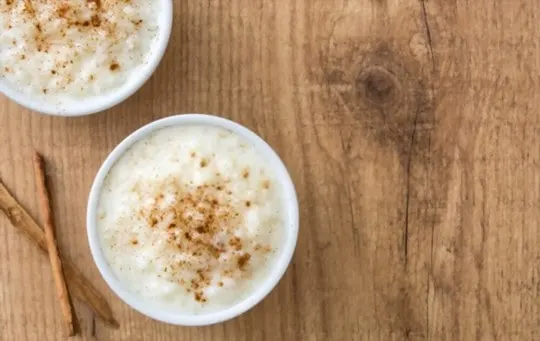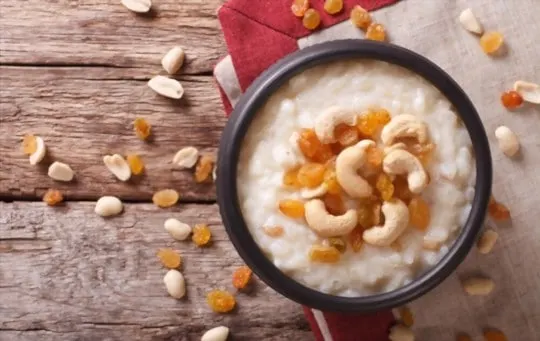Rice pudding is a dessert made using rice mixed with milk and other ingredients like raisins, sugar, or honey in many different recipes.
Also, some fruit can be added to the recipe as well. It is served as a dessert and is often found in cafes.
It can also be made at home, but usually, it requires stirring to avoid lumps from forming.
Rice pudding is a simple dessert, and this article will cover the various steps in making Rice pudding.
We also describe some common mistakes made by novices in making Rice pudding along with thickening.
How to Make Rice Pudding?

Rice pudding is a simple and delicious dessert. It is made by cooking rice in milk and sugar, vanilla, or other flavorings, such as cinnamon or lemon peel.
You can also add raisins to the rice pudding. When you cook rice in milk, it breaks down and thickens the milk.
This is similar to preparing risotto or Carnaroli Risotto with Saffron.
The technique is almost the same for both preparations, and both lend themselves well to experimentation.
For example, try using a lemon peel or cinnamon in your rice pudding recipe. The recipe described here is a simple one without any additional flavorings.
However, you can add some lemon peel or vanilla essence to it for added flavor. It is also spiced with nutmeg, making the dish all the more interesting and exotic to eat.
The use of two types of rice makes the dish more interesting. Here are the steps for making rice pudding:
- Start by mixing the milk with rice, sugar, and nutmeg. While you are doing this, keep stirring the mixture so that no lumps form. You can use some butter in the preparation to make it more palatable.
- Once you get a smooth consistency, add the rice mixture to a pot with simmering water. Make sure you stir the mixture continuously to avoid lumps.
- Simmer for about 35-40 minutes or more, often stirring, on low heat. The rice will break down and thicken the mixture. Keep checking for consistency from time to time. When done, remove from heat and let it cool before serving with an added sprinkle of nutmeg.
- As mentioned above, you can add a few drops of lemon or vanilla essence to the mixture for flavor. You can also substitute half of the milk with cream to make it more creamy and thick.
Why Your Rice Pudding is Runny & Watery?

To get a smooth and creamy consistency in the rice pudding and avoid lumps, it is important not to stop stirring.
This can be challenging for novices as they often tend to keep cooking or leave the mixture unattended for too long.
However, you must continue stirring till the time all the milk has been absorbed by the rice.
The pudding making is almost complete when the mixture has a creamy and smooth consistency to it.
When you add more milk, there shouldn’t be lumps in the mixture, or else your rice pudding will become watery.
Rice tends to form lumps easily unless properly cooked first. You can avoid this by ensuring that you stir while you are adding milk.
Another reason rice pudding runs runny is because of the proportion of milk.
The ratio of milk to rice should be 1 part rice and 2 parts milk.
If there is not enough rice in the mixture, it will become watery as there are no grounds to absorb more milk.
However, if you add too much rice, it can cause lumps, making the pudding runny.
Other Mistakes When Making Rice Pudding?

There are several other mistakes made by novices who try to make rice pudding.
For example, boiling the milk first makes it more difficult to get a smooth consistency in your rice pudding.
Since the rice is cooked in this boiled milk, you will have lumps and less chance of getting rid of them.
Therefore start with cold milk instead while preparing rice pudding.
Another mistake that people make is to use only 1 part milk and more than 3 parts rice.
Milk takes longer than the time taken by the rice to break down properly, which can be a reason for the watery or runny consistency in your pudding.
Do not add too much salt, as it will make the rice harden. The correct amount of salt is only enough to make the rice palatable.
You can use vanilla essence instead of salt if you want a different flavor in your pudding.
Once you have mixed all the ingredients well, allow them to cool before storing them in the refrigerator.
It should be left overnight for the flavors to blend well and stored for up to 3 days.
The ratio of milk and rice is the most important thing that you need to keep in mind when making a creamy and delicious pudding.
The consistency of your pudding will entirely depend on how much milk has been added, so do not rush while cooking it.
How to Thicken Rice Pudding?

Rice pudding can be thickened by cooking it longer than usual.
You also need to stir the mixture often to avoid lumps formed when the rice absorbs all the milk.
Using more rice will also make the pudding tenderer smoother, while adding more milk will give you a runny consistency.
Below are a few different methods to make rice pudding thicker.
1 – Use Cornstarch
The best way to thicken rice pudding is to use cornstarch. All you have to do is mix 3 tablespoons of cornstarch with a little milk and add it at the end when making your rice pudding.
It will immediately thicken the rest of the mixture, and you can enjoy this creamy treat.
2 – Use Mashed Bananas
Another way to thicken rice pudding is by adding mashed or sliced bananas.
For this, you need to add 1-2 pieces of banana while making the pudding.
This can be done at the end, just before serving, and will make your rice pudding much thicker in texture. A good option if you are not a fan of using cornstarch.
3 – Add More Rice
If you want to thick rice pudding a lot more, you can use more rice. This will make it very creamy and tasty in a short time.
This can be used as a last resort to thicken rice pudding if you do not have any cornstarch or bananas on hand.
4 – Use Less Milk
Using less milk in your rice pudding will make it thicker and give the dish a grainy texture instead of creamy and smooth.
It might also taste watery since there is not enough milk for the rice to absorb.
5 – Add Eggs
Adding a few eggs to your rice pudding while preparing it will make it thicker.
However, you need to be careful when doing this, as it can affect the consistency of your pudding.
Some people may not like the texture of the extra long-cooked egg and the taste of it in their dessert.
6 – Blend Your Rice Pudding
If you try to get rid of lumps in your rice pudding, blending it is the best solution. You will have to use a blender or food processor for this.
Ensure that you do not overdo it so that the texture of the pudding does not become too runny or lumpy.
7 – Make Rice Pudding in a Slow Cooker
If you want to make your rice pudding creamy and thick without adding too many ingredients, using your slow cooker is the best method.
It works by cooking the mixture on low heat for a long time until it has reached the desired consistency.
This is known as slow cooking. You can definitely try this method out if you do not want to add an extra spoonful of corn starch.
Conclusion
Rice pudding is very popular comfort food, especially among children who love this sweet treat.
It can serve as an excellent dessert or snack, and it can be enjoyed any time of the year.
However, if you are not satisfied with the consistency of your rice pudding, which might be too runny, you have many options to choose from.
With this information, you will be able to make your perfect creamy and smooth, tasty rice pudding in a few minutes.

How to Thicken Rice Pudding? Easy Guide to Thicken Rice Pudding
Ingredients
- Rice pudding
- Whisk or spoon
- Stovetop
- Your preferred thickening ingredient
Instructions
- Prepare all the required ingredients and equipment in the article.
- Select and follow your desired method to thicken.
- Depending on your desired thickness, you can add more or less.
